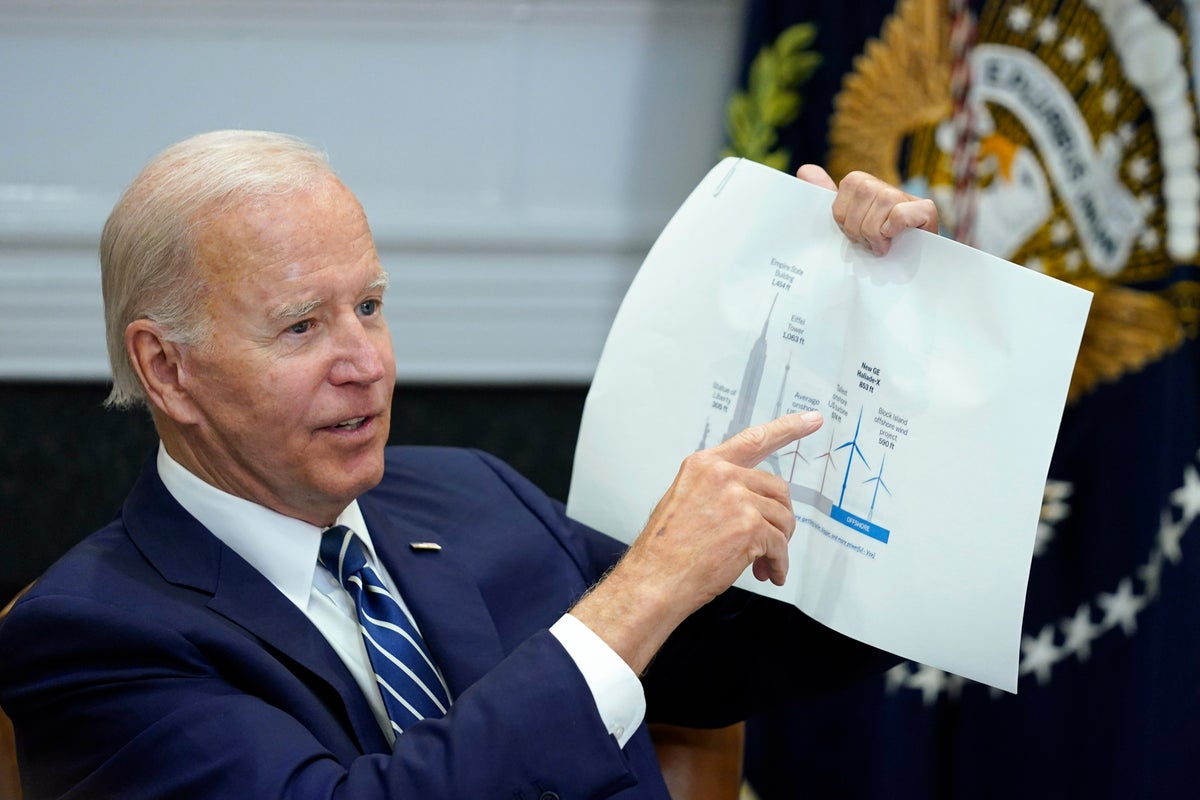
The Biden administration on Thursday announced plans to develop floating platforms in the deep ocean for wind towers that could power millions of homes and vastly expand offshore wind in the United States.
The plan would target sites in the Pacific Ocean off the California and Oregon coasts, as well as in the Atlantic in the Gulf of Maine.
President Joe Biden hopes to deploy up to 15 gigawatts of electricity through floating sites by 2035, enough to power 5 million homes. The administration has previously set a goal of 30 GW of offshore wind by 2030 using traditional technology that secures wind turbines to the ocean floor.
There are only a handful of floating offshore platforms in the world — all in Europe — but officials said the technology is developing and could soon establish the United States as a global leader in offshore wind.
The push for offshore wind is part of Biden’s effort to promote clean energy and address global warming. Biden has pledged to cut greenhouse gas emissions in half by 2030. A climate-and-tax bill Biden signed last month would spend about $375 billion over 10 years to boost electric vehicles, jump-start renewable energy such as solar and wind power and develop alternative energy sources like hydrogen.
“Today we’re launching efforts to seize a new opportunity — floating offshore wind — which will let us build in deep water areas where turbines can’t be secured directly to the sea floor, but where there are strong winds that we can now harness,'' White House climate adviser Gina McCarthy said at a news conference Thursday.
Deepwater areas in the Pacific especially have potential to vastly expand offshore wind energy in the U.S., McCarthy and other officials said.
McCarthy acknowledged that the floating technology is at an early stage. But she said “coordinated actions” by federal and state officials, working with the private sector, can position the U.S. "to lead the world on floating offshore wind and bring offshore wind jobs to more parts of our country, including the West Coast.''
Two pilot projects are planned off the north and central California coast, and a third is planned in southern Oregon, officials said.
“We think the private sector is going to quickly see the real opportunity here not only to triple the country’s accessible offshore wind resources but to make the U.S. a global leader in manufacturing and deploying offshore wind,'' added Energy Secretary Jennifer Granholm.
Emerging technology for floating platforms “means there’s real opportunity for the American people: an opportunity for greater energy security, greater energy affordability, cleaner air, cleaner water and of course tens of thousands of good-paying in-demand jobs,'' such as electricians, engineers, ship builders and stevedores, Granholm said.
Granholm, a top booster for U.S. efforts to promote clean energy, said the Biden administration "is all-in on making floating offshore wind a real part of our of our energy mix and winning the global race to lead in this space. And that’s why we set this big, hairy audacious goal'' of 15 gigawatts of floating offshore wind by 2035.
Interior Secretary Deb Haaland said her department has approved the nation’s first two major offshore wind projects in federal waters and has begun reviewing at least 10 more.
An offshore wind lease sale off the New York and New Jersey coast set new records, she said, and a lease sale also was held in North Carolina. Seven lease sales for offshore wind projects are planned by 2025.
More than half of the nation’s offshore wind resources are in deep waters where traditional offshore wind foundations are not economically feasible, Haaland said, adding that "floating wind will help us reach areas once not attainable. And this is critical because floating wind will help us build on the administration’s goal of 30 gigawatts of offshore wind by 2030.''
The world's first floating wind farm has been operating off Scotland’s coast since 2017. Norway-based Equinor, which operates the 30-megawatt Hywind Scotland project, is building a huge, floating offshore wind farm off Norway to provide electricity for offshore oil and gas fields.
Lauren Shane, a spokeswoman for Equinor in the United States, said the company is optimistic about floating offshore wind. “We see the potential for it. We’re always evaluating opportunities and we’re committed to the U.S.,” she said. “We’re excited about the development of offshore wind in the U.S.”







